
Earlier this year I had an idea for a fun article full of cameras with strange names, so I put together a list of 10 Unfortunately Named Cameras. The week before I was going to post the article, COVID-19 was officially declared a pandemic and my country started to shut down, so I quickly added an eleventh camera called the Corona and now the list was Eleven Unfortunately Named Cameras.
That article has gone on to be my most viewed so far in 2020, and while I’m never one to deprive people of more of what they want, you all gave me so many good suggestions of other Unfortunately Named Cameras, I knew I had to do a part two.
So here it is, back by popular demand, Even More Unfortunately Named Cameras, all suggested by the readers of this site!
Montanus
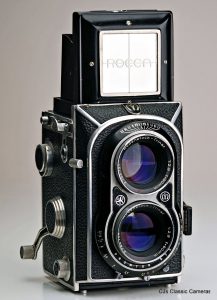
There were quite a bit of butt related jokes in the first list of unfortunate cameras, so why stop there? This suggestion comes from my friend and frequent contributor, Mike Novak who chuckles at derriere themed cameras like those made by the German company Montanus. I assume the name was meant to suggest majestic mountains, but instead guys like me only see ANUS in the name.
Originally operating under the name, Potthoff & Co. in Solingen, West Germany, around 1954 the company changed names, calling themselves Montanus Kamerafabrik.
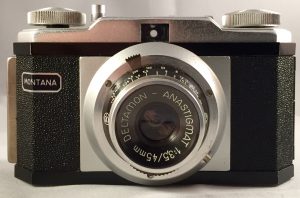
The company produced a number of 35mm and roll film cameras, the prettiest, and most GAS-worthy of them all were their high end TLRs that sold under a variety of names like the the Montanus Rocca Super Reflex, Montiflex, and Ultraflex. This TLR was a worthy Rolleiflex competitor with fast f/2.9 lenses, a film advance lever, automatic film transport, and a unique compartment on the bottom of the camera that holds a focusing magnifier and a spare roll of film.
Where most Japanese companies were content with ripping off both the features and the look of German TLRs, Montanus gave their premium TLRs their own look that is highly sought after by collectors today (myself included).
As you might imagine though, an attractive, and very capable Rolleiflex competitor that was produced in low numbers is very hard to find today and these don’t often show up for sale. When they do, the prices are quite high, so if you have a budget like mine, this unfortunately named camera will unfortunately have to remain on my “wish list”.
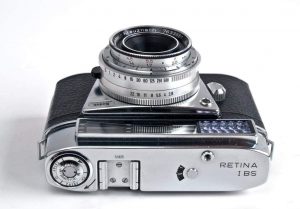
Kodak Retina IBS
Continuing on with a butt theme, we have the very unfortunately named Kodak Retina IBS. OK, OK, it’s really the I BS, but come on….the joke wouldn’t be as funny.
By the end of the 1950s, Kodak’s German division Kodak AG was starting to wind down it’s long and very successful line of folding Retinas, replacing them with non-folding versions and their new Retina Reflex SLR.
One of the first of the non-folding Retinas was the top of the line Retina III S. Featuring most of the features of the folding Retina III C, the III S had a rangefinder and lens with an interchangeable front grouping that was compatible with the III C and Retina Reflex S, but like most Retinas was quite expensive.
Kodak already had the lower end Retinette series, but apparently there was enough demand that in 1962, they decided to create a camera with the body and meter of the III S, but without a rangefinder or the interchangeable front lens groupings, and call it the Retina I BS.

The letters “BS” were likely chosen as the camera was a combination of the earlier folding Retina I B, and the III S and not as some type of awareness of a crippling bowel disease of the same name. According to Wikipedia, IBS is thought to be suffered by as many as 10-15% of the world’s population, and it’s most common symptom is abdominal pain and changes in the pattern of bowel movements without any evidence of underlying damage. Many people with IBS suffer from a negative quality of life, and although there are treatments to subdue it’s symptoms, there is no cure.
Today, I would have to imagine that if Apple or Chevrolet wanted to release a new product called the IBS, someone would probably tell them not to, but in the early 1960s, I guess awareness of it wasn’t as big.
Maybe “unfortunate” isn’t the right word to describe this next camera, perhaps “hilarious” would be a better choice.
However you view it, the Five Goats TLR is an uncommon variant of the Chinese made Pearl River TLR, which itself is related to the Seagull TLR.
While I enjoy digging into histories of cameras on this site, the world of Chinese cameras is one I haven’t even scratched the surface of. A combination of a lack of exported Chinese cameras (at least from the mid 20th century) and China’s secretive government makes finding conclusive info about their cameras really difficult.

It’s obvious the Five-Goats is based off a Rolleicord copy. It shoots 6cm x 6cm exposures on a traditional moving bed design with Bay-1 filter mounts, has a knob film advance, and what is likely a 3-element 75mm f/3.5 lens.
Beyond that, I found very little info about the Five Goats camera. Here in the United States, if you’re interested in owning five goats, you’d have a much easier time buying five actual goats!
If the name Five Goats gave you a chuckle, it’s worth mentioning a couple other Chinese cameras with non-camera-like names, such as the Great Wall, Dong Feng, and my favorite, the Seagull rebadged B.I.G. Twin 4.
I don’t know if anyone from the Chinese camera industry would ever read this post, but if you do, and you’re looking for suggestions on a new Chinese camera, might I suggest the “Twelve Monkeys”? That was a great movie!
A camera with the name “eye” doesn’t really sound all that unfortunate, does it? After all, the eye is kind of like a camera, there’s a lens, a retina, and an optic nerve which functions similarly to a digital sensor or film plane. How could this be unfortunate?
If you don’t already know, I kind of feel bad bringing it to your attention because it’s one of those things that once you see it, you can’t unsee it.
Here, let me make it bigger for you…

Boobs.
The logo looks like a pair of boobs, mammaries, breasts, hooters…whatever you want to call them. Just think about it. Someone working for Konica in the early 1960s decided to stylize the logo of this otherwise nice half-frame electric eye 35mm camera with two left facing round cups with nipples in the middle. If you really stare at it long enough, the “Y” in the middle could even be cleavage.
And just so you don’t think I’m some sort of depraved teenager who thinks about this sort of thing all day long, there’s even more to this as a reader of this site pointed out that another way to look at this logo is the letters CYC, which in Polish translates to…you guessed it, boobs.
It gets better, using a Polish text to speech translation, phonetically, “cyc” sounds to me an awful like “tzitze”, or simply, “tits”.
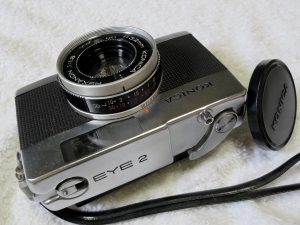
Perhaps realizing that they just marketed a camera with a pair of boobs for a logo, when this camera was updated in 1967 to include a new CdS meter, the name was changed to the Konica Eye 2, and the boob logo was removed, replaced with a simple block letter name, clearly spelling out “EYE 2”.
So there you have it, the Konica Tits, a pretty nice 35mm half frame camera, but not nearly as exciting as the real thing.
Thankfully when the Soviet FED factory copied this camera and released it as the Mikron, it’s a good thing they didn’t call it the FED Siski (Сиськи).

Junka-Werke Junka
Generally when a company makes something, it’s always a good idea to make your customers think your products are good. It’s probably not a good idea to give a name to whatever it is that you sell called the “Crapola”, “Breaksalot”, or “Junk”.
Apparently someone working for a little known German company from the 1930s didn’t get that memo as evidenced by the curiously named Junka-Werke Junka. Now it’s entirely possible that the word “junk” had a completely different meaning in 1930s Germany, or that perhaps the creator of this camera and it’s company was someone named Wolfgang Junkschmidt, but there’s really no way to tell, so I guess I have the freedom to make up whatever explanation I want.
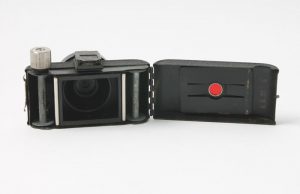
Looking at the Junka, the name might be a little more appropriate than I originally thought as this looks like an extremely basic camera. What little I can find about the Junka is that it produces 30mm x 40mm images on paper backed unperforated 35mm film, similar to Japanese “Bolta” film.
Featuring a 4.5cm f/8 lens that is likely a single element meniscus, the shutter has only a single speed with what looks to be an Instant and Bulb mode and possibly a cable release on the side. Inside of the camera, the film plane is flat and not curved like most other simple cameras, which means edge sharpness on images shot with the Junka is probably terrible.
I guess if someone really wanted the cheapest possible camera they could buy, something like the Junka would be exactly what you want. So I take everything back and retract this camera’s inclusion on this list of unfortunately named cameras as it’s rather appropriately named!
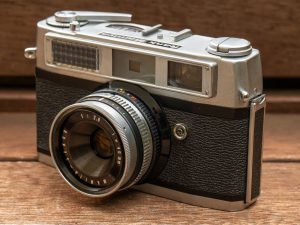
Rank Mamiya
A challenge when collecting old cameras is dealing with ones that have spent decades sitting in a camera bag in a musty closet, basement, or garage. When this happens, moisture often gets trapped in the ever ready cases that 20th century cameras often came in, and that can lead to some pretty bad smelling cameras.
It’s not unusual for me to get a stinky camera and have to let it air out for weeks, or in extreme cases, months with some silica gel or coffee grounds nearby to help mitigate the smell.
 Apparently, someone in the marketing department for Mamiya back in the early 1960s foresaw the challenge of stinky cameras and wanted to offer some kind of warning to future collectors when they named their new 35mm rangefinder, the “Rank Mamiya”.
Apparently, someone in the marketing department for Mamiya back in the early 1960s foresaw the challenge of stinky cameras and wanted to offer some kind of warning to future collectors when they named their new 35mm rangefinder, the “Rank Mamiya”.
Why “rank”, which according to the Merriam-Webster dictionary says when used as an adjective, means offensive in odor, cross, foul, or putrid, is anyone’s guess. Maybe they meant to use the word rank to mean “high ranking”, but if that were the case, wouldn’t they have called it the Mamiya Rank?
What’s even weirder is that the Rank Mamiya was only sold in the UK, elsewhere it was the Mamiya Ruby, a way better name as the name ‘ruby’ brings up visions of a pretty, red gemstone, not an offensive or putrid smell. Why on earth anyone thought “rank” was a better name than “ruby” is one of mankind’s greatest mysteries. Maybe this was a subtle dig at the UK, suggesting that perhaps people from that country had questionable hygiene. Whatever the reason, whether or not all Rank Mamiyas smell bad, if you encounter one that does, you can’t say you weren’t warned!
Another suggestion from a reader of the previous list is the Wenk Wenka. This attractive, but very strange looking 35mm rangefinder camera was made for a very short time right after the war in Nuremberg, Germany.
The Wenk Wenka has an interchangeable 40mm screw lens mount that is most commonly found with a Schneider Xenar 50mm f/2.8 lens, but reportedly had at least two other lenses available for it. The camera shoots 24mm x 30mm images on regular 35mm film, giving up to 45 exposures on a 36 exposure cassette of film.
Early versions of the camera had a coupled combined image rangefinder in which the rangefinder patch was the same size as the main viewfinder, meaning that the entire viewfinder image could be used to focus the image, not just the center like in other combined image rangefinders. In order to accomplish this, the rear viewfinder window was situated halfway between the two front windows, and both rangefinder windows were reflected with mirrors. Later versions of the Wenka lost this feature, instead switching back to a smaller rangefinder window like on most other cameras.
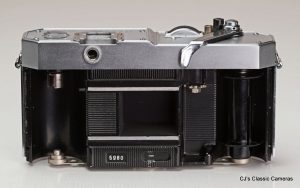
The camera also has a unique metal blade shutter that on earlier models reached speeds up to 1/800 second and is fully flash synchronized at all speeds. The shutter had two curtains with a variable spaced slit that changed size depending on the selected shutter speed. It’s location was immediately behind the lens, and not at the focal plane, like most two curtain shutters were. Changing shutter speeds was accomplished by rotating the black wheel that sticks up on the top plate, right next to the shutter release.
So far, the most unfortunate thing about the Wenk Wenka is that they’re very rare, with less than 500 said to be made throughout the entire life of the camera, I’m not likely to ever find one, but the second most unfortunate thing is that according to Urban Dictionary, the word “wenk” is slang for masturbating! WHOOPS!
And speaking of self-gratification, I bet if you tell 100 people that you’re looking for a Felica Klimax, I predict zero of them will think you’re searching for a camera. You’re not going to need the Urban Dictionary for this one!
Yet in 1957, a German company called Vredeborch GmbH produced an inexpensive plastic box camera with a meniscus lens and single shutter called the Felica. The Felica was an entry level camera aimed at children or beginners to photography so many likely were trashed over the years and are very hard to come by today.
The Vredeborch Felica was sold in markets outside of Germany under a couple of different names, one of which was the Klimax. My best guess would be that name was chosen to represent the pinnacle or top of something, like the climax of a mountain, but this is 2020, and things always have double, and triple meanings, and well, if you sell a product called the Klimax, it’s probably going to be sold at drug stores, locked in a glass cabinet next to the condoms.
Non-English Translations
Many of the cameras in this, and in my first list of Unfortunately Named Cameras are there as a result of some word that was chosen which has an unfortunate translation in the English language. Sometimes it’s a vulgar or humorous piece of slang that didn’t exist when the camera was first built, but other times, perhaps it’s creators should have known better. There’s no way Minolta could have known in the 1960s that two decades later, a sitcom revolving around a cute and fuzzy space alien with an appetite for cats would be named ALF just like their camera. Still it happened, and it’s funny.
But each of those examples require the name or acronym to mean something in English. Once you start to include unfortunate meanings in other world languages, you open the door to a whole bunch more funny connotations. Thanks to feedback from the first Unfortunately Named Cameras article, here are some suggestions from site readers for cameras that have names that mean something funny in another language.
Today, smartphones are the ubiquitous device for people all over the world. They are multi-tasking electronic computers that can make phone calls, play music, watch videos, and take photos. Our desire to include multiple functions in a single device is not unique to the modern smartphone, as in 1959 Kowa of Japan released a hybrid radio and 16mm camera which they cleverly combined the words “Radio” and “Camera” to come up with Ramera.
Ramera is also Spanish for a prostitute.
In an ironic coincidence, the most common color for the Ramera was red (other colors were available), which suggests it might have fit in well in “red light districts”.
AGFA Trolita
In 1938, AGFA produced a large variety of medium format roll film folding cameras. With names like the Billy-Clack and Isolette, you could have a camera at nearly every price point.
Somewhere in the middle of their lineup was a mid-priced model called the AGFA Trolita. What little information I could find about it suggests it was only available in Germany, and never exported to the United States. According to my very poor attempt at a German to English translation of the page to the right from AGFA’s 1939 catalog, the Trolita could shoot both 6×9 and 6×6 via a mask, and came with a f/4.5 Apotar lens set in a Prontor II shutter.
You’re probably wondering what possible translation I might have found for the word “Trolita”. You’re not going to believe this, but like the “Ramera” above, in Argentina it is a slang word for a prostitute. Pro tip: Do not do a Google search for the word “Trolita” while at work!
In 1908, a German mechanic named Max Baldeweg created a company to manufacture shutters, film holders, and other pieces of photographic equipment. His new company would eventually be called Balda-Werke Max Baldeweg and throughout the next several decades, would produce a large quantity of 120, 127, and 35mm cameras including models like the Baldina, Jubilette, and Baldi.
In 1840, a Russian poet wrote a short story called “The Tale of the Priest and of His Workman Balda”, telling the story of a lazy priest who hires a man to work for him who agrees to work for a year without pay except that he be allowed to hit the priest three times on his forehead as a means of payment.
Later in the 20th century, various versions of this same story were produced as cartoons or stop motion films in 1933, 1940, 1956, and 1973 where the character of Balda is portrayed as an unintelligent simpleton. In the years that would follow, the word “Balda”, or Балда, has come to mean any stupid or not-serious person.
So while the camera company Balda was clearly taken as a shortened version of it’s creator’s last name, in Russian, if someone called you a balda, take it as an insult.
Kowa Kallo
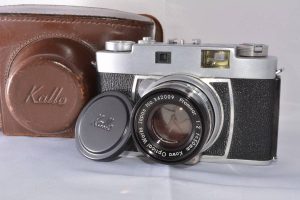
Oh geez, here we go again with another Kowa camera. How many more translations for the word “prostitute” can I find?
In 1955, Kowa of Japan produced a 35mm fixed lens rangefinder called the Kowa Kallo 35. The Kallo was an attractive camera with a leaf shutter and came with a variety of Prominar lenses ranging from f/3.5 to f/2.
A later version of the Kallo came with an uncoupled selenium light meter and was also sold by Graflex in the United States as the Graflex Century 35 that was identical other than the name.
For most of the non-English speaking world, the letter “W” is often pronounced like a hard “V”, so for people in those countries, Kowa would have been commonly pronounced like “Ko-va”. For those who speak Finnish, the translation of the name Kova Kallo is “hard skull”.
Even More Stupid Bird Names
In the last installment, I included a bonus section of what I called “Stupid Bird Names” where I commented on the unusually high number of cameras with bird names. I mentioned cameras like the Pigeonflex, Robin, Penguin, Sure Shot Owl, and the Seagull, all of which I said were pretty lame because if you’re going to name a camera after a bird, it should be something cooler than a pigeon.
In the comments section you all pointed out that there are not only even more cameras with bird names, but that some of the birds represented are definitely not stupid! Not willing to let the injustice of not naming every single bird reference I could find in the camera world, here are even more stupid cool bird names!
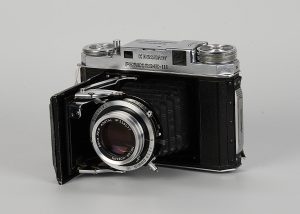
The first two are both from the Leeds, UK based Kershaw-Soho Ltd whom I previously called out for their Kershaw Penguin camera, but I failed to realize that in Kershaw’s catalog lurked two much cooler bird cameras, the Peregrine, and the Raven.
The Peregrine Falcon is a large crow sized bird of prey that is considered the fastest bird in the world, reaching speeds of up to 200 mph while swooping down on it’s unsuspecting victims like the Chuck Norris of birds! The Peregrine camera is probably less cool than the bird it’s named after, but is still a highly capable and very attractive looking 6×6 folding camera that in it’s top of the line Peregrine III trim, has an excellent Taylor Hobson lens, 8 speed shutter, and a coupled rangefinder.
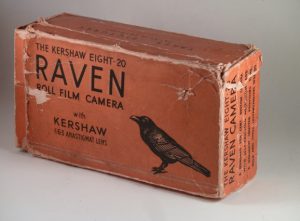
The Raven camera is a bit less cool than the Peregrine, but gets it’s name from it’s all black Bakelite body. Beyond that, the Raven was a rather ordinary folding bellows camera that shoots 6×9 images on 120 roll film, but at least came in a pretty cool box!
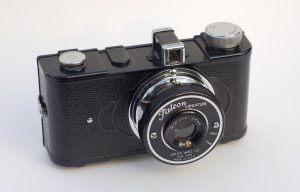
And then there’s the Falcon Candid camera, which was one of many cameras produced by the Chicago Cluster of similarly designed and spec’d candid cameras from the 1930s and 40s that mostly shot 127 roll film. It’s a cool name, for an otherwise un-cool camera.
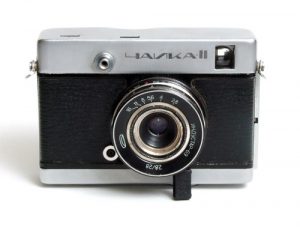
Finally, there’s the 35mm half frame Chaika which means “seagull” in Russian, and although I previously mentioned the Chinese Seagull cameras in the first article, there’s something about saying “Chaika” with a fake Russian accent that makes it sound way cooler than “sea gull”.
 Carl Zeiss Loxia, Otus, Batis, Touit, and Milvus
Carl Zeiss Loxia, Otus, Batis, Touit, and Milvus
Holy shit! Someone at Zeiss really likes birds! If you’re looking through a modern Zeiss lens catalog, you would be forgiven if you thought you picked up a pamphlet for Ornithology.
The names Loxia, Otus, Batis, Touit, and Milvus are all names of different families of lenses that Zeiss makes for Nikon F, Canon EF, Fuji X, and the Sony E-mount. Some cover a full 35mm frame, and some are made only for APS-C sensors. Those same names are also a type of genus of Finch, Scops Owl, Parrot, Red Kite and something called a Passerine bird.
Clearly, this was intentional as I can’t imagine that any company could accidentally name 5 different products after names all relating to the same type of animal.
Bonus: Leitz NOOKY
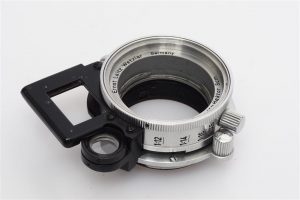
It’s not a camera or a lens, but it’s widely known that Leitz created five letter catalog code words for most of their camera products. In most cases, these code words mean nothing and usually didn’t appear on the products themselves. People who bought a APDOO, likely never knew that’s what it was called.
- IGEMO – Leica M3 Body
- FODIS – Auxiliary Rangefinder
- APDOO – Self Timer
- SBLOO – 35mm Viewfinder
On occasion though, these seemingly random arrangement of letters produces something like the NOOKY, a close focusing adapter for Elmar 5cm lenses. So if you’re in the market for a NOOKY, and your wife catches you browsing Craig’s List, you might have some explaining to do!




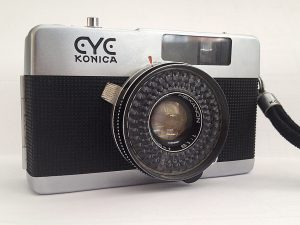
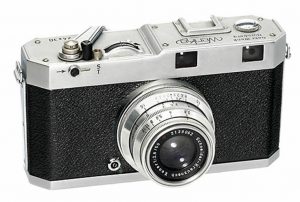
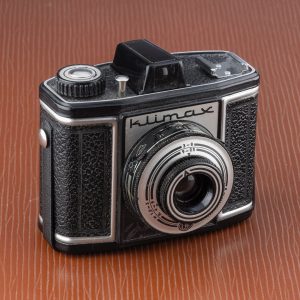
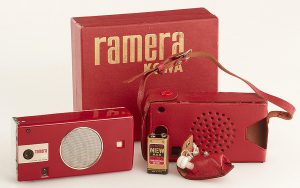
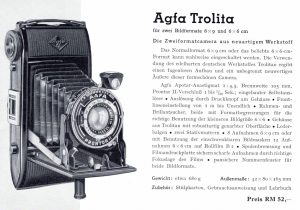

Don’t forget the Leitz Imarect (though it does not work with nooky which is a shame)
Droog? Elegaflex?
The Droog actually was suggested in the comments of the original article and in an early draft, I was going to include it, but that’s a camera I actually hope to be able to give a legitimate review to someday, so I decided to skip it.
Hi Mike, again, a very interested article full of fun. both “pearl river” and “five goats” are related to the city of Guangzhou. Guangzhou is called five goats city or goat city for short, due to a fairy tale. see this link:https://en.wikipedia.org/wiki/The_Legend_of_Five_Goats
Another excellent article! I wonder if the word Trolita comes from the same origin as the word Trollop? Anyway, thanks for featuring my photo! I’ll let you guess which one this time!
Thanks for the compliments John! I swear I am not trying to rip off your images in these posts, they just so frequently show up in Google Image searches and it’s not always clear where they come from. For “fun” articles like these where I do not own most of the cameras, I have to rely on found images online. Whenever I do my own reviews, I try to use as many of my own images as possible to avoid stepping on other people’s toes.
The Rank Organisation owned by J Arthur Rank, was a huge British conglomerate which owned a large number of companies … film studios, cinemas, projection equipment, audio, TV …. the list goes on, he was big into vertical integration .. Rank films shown at Rank cinemas on Rank Projectors with Rank sound haha.. One of the companies under the Rank umbrella was Kershaw (who made the Penguin, Perregrine, Raven etc.) who stopped making cameras to concentrate on cinema projectors, another was Aldis, who made slide projectors. I’ve seen the Rank Mamiya also badged as Rank Aldis … guessing they did a deal with Mamiya and distributed it under the Rank name in the UK. Incidentally J Arthur Rank was so big a name that his name is also UK rhyming slang for a wank … to masturbate.
Yeah, I did see references to the Rank Organization in my limited research for this article, but left it out of the article as it would have been way less funny! 🙂
These are fun articles, Mike – much needed these days. Sure am glad SOMEone wrote up Leitz’s NOOKY. And that it wasn’t me that did it.
Glad you liked it! I think it’s important to supplement all the reviews on my site with some humor as it’s difficult to consistently maintain such a high level of journalistic integrity! 🙂
“Trolita” can also be translated as “small lie” in Spanish (“trola is mentira/lie). Being Spanish, never heard of trolita as slang for prostitute; the Spanish spoken in Latin America is very rich and has lots of single country or even single region/city localisms
“Balda” means shelf in Spanish too
I did find a reference to it on some website when I originally wrote this, but sadly, can’t remember. For humor posts like this, I don’t spend as much time checking my references. 🙂
Only in Argentina is it understood that way. “Trolita” is even worse, as it can refer to an underage prostitute! Nowadays, the word is used more as an insult than anything else, when directed to a female; and when used in the male version (trolo) it’s a derisive way to refer to a homosexual man.
Agfa used to sell lots of stuff in Argentina; I’m guessing they changed the name of that camera upon importing it
“Ach so,” says “Feldwebel Schulz” of “Stalag 17.” the silly season has arrived.”
Photokina is either months ago or months away, and there’s very little photo news to be had. Popular and Modern Photography columnists had to write something, so the “Bunab 7” was born. (Kramer? Rothschild? Keppler? I don’t recall who wrote about this back then.;) It was, if my foggy memory is correct, an attachment for the Gossen Lunasix light meter. What did it do? Create an opportunity to write about a “photographic Snipe.” I guess.
That super-speedy, bigger-than-life Zeiss Super-Q Gigantar showed that even staid, established, Carl Zeiss, Stuttgart could crack an impressive joke on the photographic world/press.
These days, everybody with an electronic camera is singing the praises of the Radionar f/2.9 lens as a “great Bokeh” lens. Back in the days of Hiroshi Kimata and the MTF test lab, that was called “the laughable Radionar,” that produced “soft, mushy images at maximum aperture.” Not even a highly-regarded working-tool-of-professional photographers escaped the “funny name” stamp. I recall reading about the “Hasseldingle” more than once in it’s 1000F days. (One memorable April 1, there was a joking reference to the “Smashelblad,” which got by that pesky reflex with an internal hammer…and seven year’s bad luck per exposure!;)
To finish off this silly post, did did you come across the Ranca camera?
Did you pass on Ernst Leitz’ most interesting STENK, an otherwise ordinary rubber air blower? (Looks like an small ear syringe.)
Also, on that “Kershaw Peregrine-III,” what about that “TALYKORN”? (Odd name for a leaf shutter/’)
Leitz had a bunch of goofy sounding accessories and I could probably do a whole article on them. I picked NOOKY as I thought it was the funniest! Who knows, maybe I’ll go over those in part three!
Re: bird names. I have a Wray Owl, a prototype 35mm camera, of which a grand total of only six were made. Eventually, some parts and mechanisms (shutter?) of this camera were eventually used in the (production) Wrayflex
Re: Bird names. The Kershaw Peregrine III pictured in the article above is a 6×6 format, coupled rangefinder camera and was Kershaw’s top camera in 1948-1949 when it was introduced. Sporting a superb Taylor-Hobson 80mm f2.8 Adotal lens in 9 speeded Talykron shutter (1-400 +B).
Kershaw also made many cameras that were for 6×9 format. Arguably the best of those was the Curlew III, yes another bird name. Well, the directors were ornithologists after all.
The Curlew III also has a superb Taylor-Hobson lens, this time a 105mm f3.8 Roytal lens in the same 9 speeded Talykron shutter, not as fast as the Peregrine III, and the Curlew is just a viewfinder camera (no rangefinder on this one).
Other bird named cameras in the Kershaw lineup included: Penguin, King Penguin, and Raven, under Soho there was also a Myna.
You for got The Zeiss Ikon “Kolobri” – German For “Humming-bird” the 127 Camera. A real cutie of a camera; which while a good camera had the viewfinder on the wrong axis